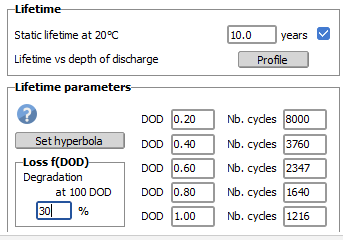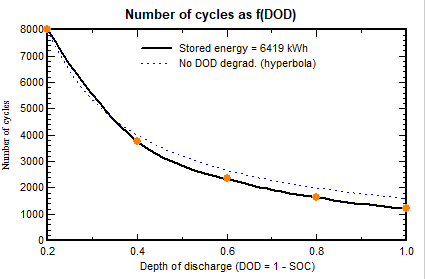|
<< Click to Display Table of Contents >> Battery Aging, Nb. of cycles |
  
|
|
<< Click to Display Table of Contents >> Battery Aging, Nb. of cycles |
  
|
The battery ageing is made of 2 contributions:
Static aging
This is a "fatal" aging, arising whatever the battery is in use or not.
With Lead-acid batteries, this is mainly related to the sulfatation of the electrodes, and the stratification of the electrolyte (except Gel technologies). It depends on many factors: maintenance, temperature, deep discharges, discharge rate, etc.
NB: The ambient temperature is a very important factor affecting the real static lifetime. You can consider that above 25°C, the lifetime is decreased by a factor of 2 for each 10°C increase.
For Li-Ion batterie, we don't have much information about the static degradation, especially according to the temperature. A lifetime of 10 years is often mentioned on the datasheets.
Operating wearing - Number of cycles
The second component is related to the use intensity of the battery.
When using the battery (charging/discharging), there is some wearing, resulting in a slight diminution of the real capacity.
Datasheets usually specify a maximum number of cycles, for a specified depth of discharge (DOD). The end of life corresponds to a diminution of the capacity, usually down to 80% of the nominal capacity.
This number of cycles may be interpreted as a global stored energy along the life. For example, 2000 cycles at 40% DOD are equivalent to 1000 cycles at 80% DOD.
We can consider this global stored energy as a number of full cycles at 100% DOD. Therefore the number of cycles for any DOD is simply NbCycles (100%) / DOD, i.e. an hyperbolic function of DOD.
In the reality other factors have an influence on the maximum number of cycles:
| - | High charging/discharging rates increase the wearing. This is taken into account during the simulation, by normalizing the number of cycles contribution calculated at each hour to the real capacity of the battery at the concerned discharging rate. |
| - | High depth of discharge may also damage the battery, especially with Lead-acid batteries. Therefore an additional number of cycles limitation proportional to the DOD may be added to the normal hyperbolic behavior. |
Definition in the Battery dialog
The dialog allows to explicitly define 5 points on the "Number of cycles" diagram. These points are stored in the BTR data file.
When clicking the "Lifetime => Profile" button, the edition of the points will appear along with the plot:

However there are some constraints: when the hyperbola is constructed on a given point, all other points should be close, but below the hyperbola.
Therefore there is a tool for constructing the hyperbola. When clicking the button "Set hyperbola", it will be constructed in order to pass by your specified point. So that you can define the number of cycles proposed by the datasheet (usually one only point).

Degradation
You may also define an additional degradation, taking into account the accelerated aging (diminution of number of cycles) due to the depth of discharge.
PVsyst proposes a degradation rate which is proportional to the DOD, the parameter being the percentage of cycles lost if all discharges were at 100%.
During the simulation, for each time step:
oThe static ageing state is decremented as a function of the battery actual temperature as defined by the user for the simulation. This is stored in the simulation variable SOWStat (SOW stands for "State Of Wear").
oThe dynamic ageing state is accurately evaluated as function of the discharging current and the depth of discharge for this hour and the curve above. It is stored in the variable SOWCycl.
The final SOW state is the minimum of both states.
Both initial wearing states may be specified at the beginning of the simulation, allowing to chain the real state over several simulation years.
The SOW evolution value along the year determines the Battery lifetime, which may be used in the economic evaluation for the replacement costs.
If, during the simulation, one of these SOW states attains zero, the battery is supposed to be replaced and both SOW are reset to 100%.
You can see the General Model description for further details.